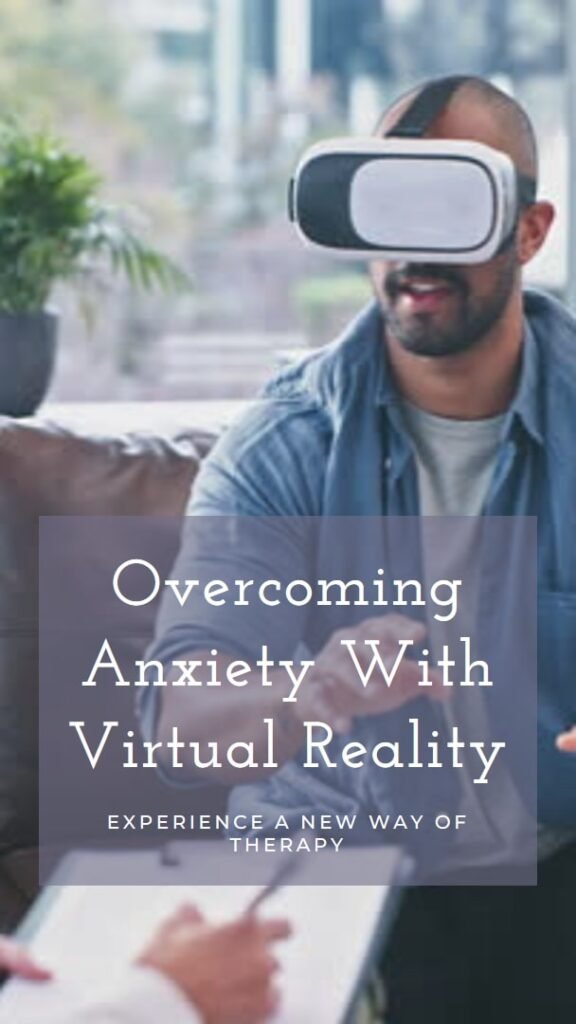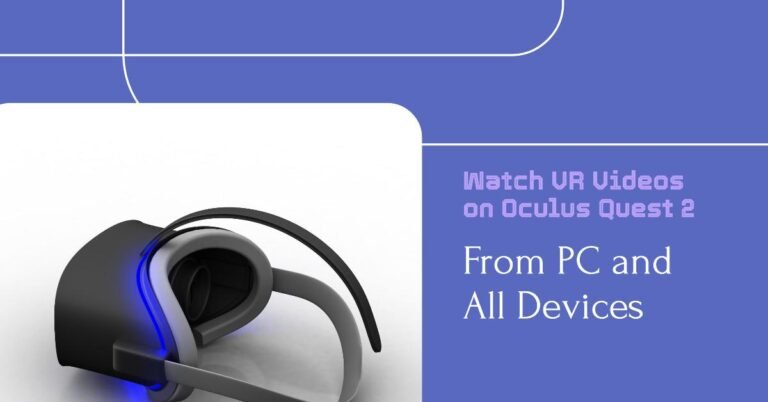Virtual Reality Exposure Therapy Is Most Likely To Prove Effective In The Treatment Of Anxiety Disorders
Anxiety disorders manifest in various forms, including phobias, social anxiety, and post-traumatic stress disorder (PTSD). These conditions can significantly impact daily life, making it challenging to work, socialize, or even leave the house. Traditional therapy approaches, such as cognitive-behavioral therapy (CBT) and exposure therapy, have proven effective in managing anxiety. However, VRET offers a unique and potentially superior alternative.
This article delves into the exciting world of VRET, exploring its capabilities, effectiveness in treating anxiety disorders, and its potential to transform the future of anxiety treatment.
Why VRET Shows Promise in Treating Anxiety Disorders
VRET leverages the immersive power of virtual reality technology to create safe, controlled environments that mimic real-life situations that trigger anxiety. Imagine facing your fear of public speaking in a virtual auditorium filled with supportive avatars instead of a real audience. Or confronting your fear of heights by virtually scaling a skyscraper without ever leaving the therapist’s office.
This controlled exposure allows individuals to gradually confront their anxieties in a safe space, promoting:
- Reduced Fear: Repeated exposure in a virtual setting helps decrease the emotional response to the feared situation.
- Increased Confidence: Successfully navigating virtual challenges builds confidence and self-efficacy in tackling real-life anxieties.
- Enhanced Safety: The virtual environment allows for controlled exposure, minimizing the risk associated with real-world triggers.
Key Advantages of VRET over Traditional Exposure Therapy
While traditional exposure therapy remains a cornerstone of anxiety treatment, VRET offers several distinct advantages:
- Greater Control: Therapists can manipulate the virtual environment to adjust the intensity and complexity of exposure scenarios, personalizing the treatment to each individual’s needs.
- Enhanced Engagement: The immersive nature of VR fosters a higher level of engagement, potentially leading to faster progress.
- Accessibility: VRET can make exposure therapy more accessible to individuals who may find real-world exposure too challenging or impractical.
Is virtual reality exposure therapy effective in treating anxiety disorders?
Yes, virtual reality exposure therapy (VRET) has shown strong evidence of effectiveness in treating various anxiety disorders. Here’s why:
- Research Supports Its Efficacy: Numerous studies and meta-analyses have demonstrated that VRET is an effective treatment for anxiety disorders, including:
- Specific phobias (e.g., fear of spiders, heights, flying)
- Social anxiety disorder
- Panic disorder with agoraphobia
- Post-traumatic stress disorder (PTSD)
- Generalized anxiety disorder
- Comparable to Traditional Exposure Therapy: Studies have shown that VRET is often just as effective as traditional exposure therapy in reducing anxiety symptoms.
- Potential Advantages: VRET offers some potential advantages over traditional exposure, including:
- Greater Control: The virtual environment allows therapists to precisely control the intensity and complexity of exposure scenarios, tailoring treatment to individual needs.
- Enhanced Engagement: The immersive nature of VR can be more engaging, potentially leading to faster progress.
- Accessibility: VRET can be more accessible for individuals with phobias that are difficult or impractical to recreate in the real world.
Here are some resources highlighting the effectiveness of VRET:
- The Effectiveness of Virtual Reality Exposure–Based Cognitive Behavioral Therapy for Severe Anxiety Disorders: https://www.jmir.org/2022/2/e26736/
- Virtual Reality Exposure Therapy as a Treatment Method Against Anxiety Disorders and Depression-A Structured Literature Review: https://www.ncbi.nlm.nih.gov/pmc/articles/PMC6823515/
While VRET might not be a guaranteed “cure,” it offers a powerful and evidence-based approach to managing anxiety disorders, leading to significant reductions in symptoms and improved quality of life for many individuals.

Real-Life Success Stories: VRET Transforming Lives
The effectiveness of VRET is not just theoretical; countless success stories demonstrate its transformative impact on individuals with anxiety disorders.
For example, consider Sarah, who battled a debilitating fear of public speaking. Through VRET, she gradually practiced delivering presentations in virtual conference rooms, starting with small audiences and progressing to larger ones. With each successful virtual presentation, her anxiety lessened, and she eventually felt confident enough to deliver a real-life presentation at a work meeting.
How does VRET work compared to traditional exposure therapy?
Both traditional exposure therapy and VRET share the core principle of gradual exposure to reduce anxiety. However, VRET offers some distinct advantages:
- Control: The virtual environment allows for more precise control over the exposure scenarios.
- Engagement: The immersive nature of VR can be more engaging and lead to faster progress.
- Accessibility: VRET can be more accessible for individuals with phobias that are difficult or impractical to recreate in the real world.
Choosing the Right Approach:
The best approach often depends on the individual’s specific needs and preferences. Traditional exposure therapy might be suitable for readily accessible phobias or when cost is a significant factor. VRET can be a powerful option for individuals seeking a more controlled, immersive, and potentially faster-acting treatment experience.
Remember, both traditional and virtual reality exposure therapy are valuable tools in the fight against anxiety disorders. Consulting a mental health professional allows for a personalized assessment and the selection of the most suitable treatment approach for your unique journey towards overcoming anxiety.
This comparison highlights that while both traditional and VRET share the core foundation of exposure therapy, VRET offers a cutting-edge approach with unique advantages. Ultimately, the choice between them should be made in collaboration with a mental health professional to ensure the best possible outcome for your individual needs.
What are the potential side effects of VRET?
While VRET is generally considered safe and well-tolerated, there are some potential side effects to be aware of:
- Cybersickness: This is the most common side effect associated with VR technology and can manifest as dizziness, nausea, disorientation, and sweating. These symptoms typically subside shortly after the VR session ends.
- Somatoform Symptoms: In rare cases, individuals might experience physical sensations like chest tightness, shortness of breath, or tingling during VRET, mirroring the physical symptoms of their anxiety in the virtual environment.
- Dissociation: Some individuals might experience a feeling of detachment from their surroundings or themselves during the VR session. This is usually temporary and resolves once the session is over.
- Psychological Distress: While the goal of VRET is to reduce anxiety, confronting virtual fears can still lead to temporary emotional distress. However, this is usually managed by the therapist during the session.
Here are some additional points to consider:
- Individual Differences: Susceptibility to VR-related side effects can vary depending on the individual’s sensitivity to VR technology and their overall mental health.
- Importance of Gradual Exposure: Therapists administering VRET typically start with shorter sessions and gradually increase the duration and intensity of exposure to minimize the risk of overwhelming side effects.
- Open Communication: It’s crucial to communicate any discomfort or unusual experiences to the therapist during the VRET session. They can adjust the settings or take breaks as needed to ensure a safe and comfortable experience.
Overall, the potential side effects of VRET are generally mild and short-lived. However, it’s essential to be aware of them and prioritize open communication with your therapist throughout the treatment process.
How much does VRET treatment cost?
Determining the exact cost of VRET treatment can be tricky, but here’s a breakdown of the factors influencing the price:
Therapist Fees:
- Similar to traditional therapy sessions, VRET is typically administered by licensed therapists, and their hourly rates will significantly impact the overall cost. These rates can vary depending on their experience, location, and practice setting.
VR Equipment Costs:
- While the VR hardware itself doesn’t solely determine the treatment cost, therapists offering VRET may factor in the overhead associated with purchasing and maintaining the equipment.
Number of Sessions:
- The total cost will depend on the number of VRET sessions required to achieve the desired outcome. This can vary based on the individual’s specific needs and progress.
Here’s a general cost overview:
- Range: VRET treatment can range from approximately $50 to $200 per session.
- Comparison: It’s often comparable to the cost of traditional therapy sessions, which can also fall within this range.
- Potential Cost-Effectiveness: Studies suggest that VRET might be cost-effective in the long run. This is because its immersive nature and potential for faster progress could lead to fewer overall sessions needed compared to traditional therapy.
Additional Points to Consider:
- Insurance Coverage: While insurance coverage for VRET is evolving, some insurance plans may offer partial or full coverage for VRET sessions. It’s best to check with your insurance provider for specific details.
- Clinics vs. Online Platforms: Costs might differ depending on whether you receive VRET at a therapist’s office equipped with VR technology or through online platforms offering VR therapy services.
Will VRET completely cure my anxiety?
While VRET is a powerful tool for managing anxiety disorders, it’s important to understand that it’s not a guaranteed “cure” in the traditional sense. Here’s why:
- Management, not Elimination: Anxiety disorders are complex conditions often influenced by various biological and psychological factors. VRET effectively helps individuals manage their anxiety symptoms and significantly reduce their impact on daily life. However, it might not completely eradicate the underlying anxiety altogether.
- Individual Differences: People respond to treatment differently. While VRET has shown remarkable success in numerous cases, the individual’s specific condition, response to exposure therapy, and overall mental health can influence the long-term outcome.
- Maintenance and Relapse Prevention: Even with successful VRET treatment, anxiety symptoms might resurface in certain situations or periods of stress. Ongoing coping mechanisms, self-care practices, and potential maintenance sessions can help prevent significant relapse.
However, here’s the positive outlook:
- Long-lasting Improvements: Studies have shown that VRET can lead to significant and lasting reductions in anxiety symptoms, often comparable to traditional exposure therapy. These improvements can translate to a substantial increase in quality of life and a sense of control over anxiety.
- Empowerment and Skills Development: VRET equips individuals with valuable coping skills and the ability to manage their anxiety response in various situations. This empowers them to navigate life with greater confidence and resilience.
Therefore, while VRET might not offer a complete “cure” for anxiety, it presents a highly effective treatment option with the potential for significant and long-lasting improvements in managing anxiety symptoms and regaining control over your life. Remember, VRET is a powerful tool in your anxiety management journey, but it’s crucial to approach it with realistic expectations and a commitment to ongoing self-care practices.
Is VRET Right for You?
If you’re struggling with anxiety disorders, VRET is a promising treatment option worth exploring with your therapist. Here are some factors to consider:
- The Severity of Your Anxiety: VRET is highly effective for various anxiety disorders, but the severity of your condition may influence the treatment plan.
- Your Comfort Level with Technology: While VR technology is becoming increasingly user-friendly, some individuals may require time to adapt.
- Therapist Expertise: It’s crucial to choose a therapist experienced in administering VRET to ensure a safe and effective treatment experience.
FAQs
Is VRET Safe?
VRET is generally considered safe when administered by a qualified therapist. However, it’s essential to disclose any pre-existing medical conditions or concerns before starting treatment.
How Long Does VRET Treatment Take?
The duration of VRET treatment varies depending on the individual’s needs and progress. However, most individuals experience significant improvement within a few weeks to a few months.
Does Insurance Cover VRET?
Insurance coverage for VRET is still evolving, but some insurance plans may provide partial or full coverage. It’s best to check with your insurance provider for specific details.
What are the different types of anxiety disorders that VRET can treat?
VRET has been shown to be effective in treating a wide range of anxiety disorders, including:
* Specific phobias (e.g., fear of spiders, heights, flying)
* Social anxiety disorder
* Panic disorder with agoraphobia
* Post-traumatic stress disorder (PTSD)
* Generalized anxiety disorder
How does VRET work compared to traditional exposure therapy?
Both VRET and traditional exposure therapy rely on the principle of gradually exposing individuals to their feared situations. However, VRET offers several advantages:
* Greater control: The virtual environment allows for more precise control over the intensity and complexity of exposure scenarios.
* Enhanced engagement: The immersive nature of VR can be more engaging and lead to faster progress.
* Accessibility: VRET can be more accessible for individuals who find real-world exposure too challenging.
What are the potential side effects of VRET?
VRET is generally well-tolerated, but some individuals may experience mild side effects such as dizziness, nausea, or disorientation, which typically subside shortly after the session.
How much does VRET treatment cost?
The cost of VRET treatment can vary depending on the therapist, location, and insurance coverage. However, it is generally comparable to the cost of traditional therapy sessions.
Will VRET completely cure my anxiety?
While VRET is a powerful tool for managing anxiety, it is not a guaranteed cure. However, many individuals experience significant and lasting reductions in their anxiety symptoms after undergoing VRET treatment.
Conclusion: Can virtual reality help with anxiety?
VRET is revolutionizing the way we approach anxiety disorders. Its immersive capabilities, combined with the controlled exposure it provides, offer a powerful tool for individuals seeking to overcome their anxieties and reclaim their lives. As research and technology continue to advance, VRET has the potential to become an even more accessible and integral part of the treatment landscape, offering lasting relief to millions struggling with anxiety.
If you’re ready to explore the possibilities of VRET, reach out to a therapist specializing in this innovative treatment approach. Take the first step towards a life free from the limitations of anxiety.







One Comment